Cinerary Urn or Reliquary with stamped circle designs
Korean

Description
Many urns of the Unified Silla period have very dense surface patterns, and this example is typical. The sides of the deep bowl are covered with a dense fish-roe pattern, and the lid likewise has rows of stamped dotted circles.
Maribeth Graybill, The Enduring Art of the Korean Potter, December 12, 2004-November 6, 2005
Subject Matter:
This bowl appears to be a burial item rather than an everyday bowl. Ashes were put in this type of urn.
Physical Description:
This stoneware vessel consists of a bowl and lid. The curved hemispheric lid has a ring-shaped knob in the center and is decorated with stamped design irregularly. The high and hemispheric bowl stands on the low foot with a flat base. This part is also decorated with densely and evenly stamped design.
This is a dark gray, high-fired stoneware lidded bowl. The lid is crowned with a button-shaped knob. A group of ill-defined stamped motifs and two rows of stamped chrysanthemums encircle the knob and decorate the lid. Two thinly incised lines run around the top of the bowl, right below the rim. Below these lines, a vertically aligned continuous horseshoe pattern decorates the outer surface of the bowl. The mouth of the bowl is upright, and the grooved edge of the rim slopes inwards. The widest part of the bowl is located towards the upper part of the body. The foot of the bowl is short and round. There are traces of three thinly incised lines drawn on the bottom of the bowl to attach the foot.
[Korean Collection, University of Michigan Museum of Art (2017) p. 79]
Usage Rights:
If you are interested in using an image for a publication, please visit https://umma.umich.edu/request-image/ for more information and to fill out the online Image Rights and Reproductions Request Form.